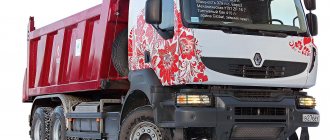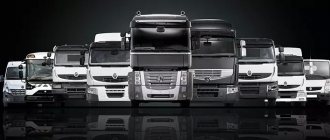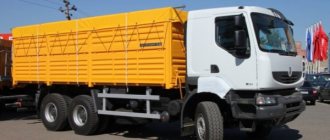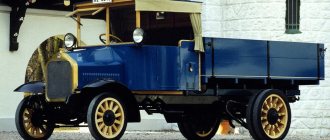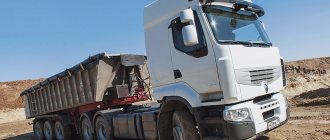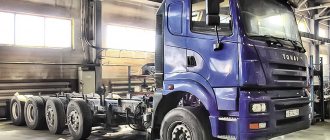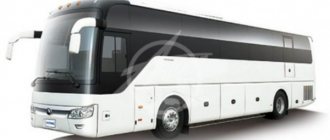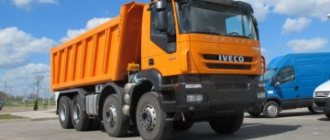Renault KERAX
A car that has become an integral part of the “landscapes” of modern Russian construction sites. Equipment with a decent service life and reasonable maintenance costs. A reliable dump truck with a durable frame, tenacious brakes and a decent level of comfort. In general, a “Frenchman” with a good reputation. And that's all about him, Renault Kerax. He feels as confident in the construction industry as Volga once did in the taxi service. And if it weren’t for him, we would have worked on the construction of a business building, the laying of the Kazan metro, the filling of the capital’s embankments and hundreds of other objects in our country... However, I can’t imagine other dump trucks in their place!"Many summers!" My first communication with carriers operating Renault Kerax took place many years ago in a sand quarry near St. Petersburg. Then I personally saw this car in work on new buildings in Chelyabinsk and laying the Kazan metro, filling roads and embankments in Moscow, in a gold mining quarry near Yekaterinburg, transporting bulk cargo in the Perm region and supplying concrete production plants in the capital and the Moscow region. Sometimes this was work in parallel with dump trucks of other brands, but most often it was the Renault Kerax that was encountered as the vehicles that won the tender for transportation at a specific site. Of course, for any brand of vehicle you can recall cases of winning tenders and give examples of successful use from the point of view of commercial benefit . But for some reason, it was the Renault Kerax that I personally came across more often than other foreign cars, and the explanation for this is quite simple: with all other consumer qualities being equal to its competitors, this truck provides good profitability. It is quite unpretentious in maintenance, quite reliable, and at a price several thousand euros cheaper. And since dump trucks are not operated individually, but in a fleet of, as a rule, several dozen units, it is not difficult to calculate the benefits. For reference: the difference in price between German or Swedish-made dump trucks of the same type, on the one hand, and a French dump truck, on the other hand, can reach 15,000 euros. And if we are talking about two dozen cars, then at the expense of the delta you can buy two, or even three “extra” Renault Kerax. Agree, the argument in favor of the “French” is weighty. And, unlike Chinese-made equipment, which is taken for a couple of seasons in order to squeeze all the juices out of it and then simply be written off or used for spare parts, the Renault Kerax becomes a “donor” only in exceptional cases: in the event of a serious accident, dismantling after theft and so on. In normal practice, even after three seasons, it remains a hardy workhorse capable of generating profit. Another thing is that over time, the costs of its maintenance gradually increase. However, in the Russian market, the demand for such second-hand equipment is quite stable, and at the same time high. In December 2007, the special price of a Renault Kerax 420.34 chassis with a 6x4 wheel arrangement and a Becema dump body with a volume of 14 m3 was 106 thousand euros. A four-axle vehicle could be purchased at a retail price of 115 thousand euros (delivery terms: DDP Moscow). For comparison: in a comparable configuration, the MAN TGA was offered for 129 thousand euros, the Volvo FH for 130 thousand euros, the Scania P-series for 131 thousand euros, and the Iveco Trakker for 134 thousand euros. But the demand for imported dump trucks in Russia is now so high that the price does not play a fundamentally important, so to speak, paramount importance. And if the transaction for the purchase of transport was arranged as a wedding, at the ceremony one could hear the following phrase: “Many summers!”, Which is quite fair: such expensive equipment is purchased for more than one season to make a profit.
For Russia One of the most common on the Russian market is a heavy-duty dump truck Renault Kerax 380.34 HD 6x4 with a Meiller body (Germany). Unlike analogues supplied to European customers, it comes to our country and the Commonwealth states with a different set of additional equipment. There is obviously no point in listing everything, but it is useful to remember some. So, the Russian version implies the presence of a Global cabin without a rear window 2 m deep on a four-point mechanical suspension and rear-view mirrors with heating and remote control (left - wide-angle), as well as a mirror for parking. The interior features a sunroof, thermal insulation and Grand froid cold climate equipment. Driver's seat with air suspension, adjustable and retractable; allows you to fully straighten your legs while resting. The cabin has a removable storage bag with a capacity of 21 liters, located behind the passenger seat. The list of other equipment includes an independent air-to-air heater AT 2000, an air conditioner with the ability to work with dusty air, a car radio for one CD with controls on the steering wheel. An electronic tachograph for 2 drivers is installed with a system for quick replacement of disks and data transfer to the instrument panel. The list includes a 12 V electrical socket for additional equipment, remote control of doors, cruise control on the steering wheel. The equipment for Russia also includes a device for cold engine starting, antifreeze down to –40 ˚C, and a power take-off mode limiter. There is control of accelerated idle speed when driving on difficult roads and an electronic regulator of the retarder mode. The maximum load on the front axle is 9000 kg. The dump truck is equipped with an S84 C power take-off with a splined shaft for a vane pump (the direction of movement is opposite to the engine). The torque is 500 Nm, the gear ratio is 0.82/0.98. The EBS electronic brake system includes ABS and emergency braking assistance. The car has torque control when reversing, differential control at speeds below 10 km/h and an alarm when the permissible braking parameters are exceeded. In addition, the electronics ensure checking the traction force of the hitch (in the case of using a trailer), coordinating the braking of the tractor and the semi-trailer, as well as connecting the retarders with the service brakes. The specification includes an electronic speed limiter (up to 90 km/h), front fog lights, fuel heating in tank, steel fuel tank for 415 l or 348 kg diesel fuel, maintenance-free front parabolic three-leaf springs (up to 9 tons). Other features include 225 Ah batteries, a rear underrun guard, and a Rockinger 400 G145 pin hitch. There is also a reinforced rear cross member for a road train with a gross weight of 40 tons, a rear underrun guard, two wheel chocks, etc. In general, the list of equipment is quite impressive. But it is precisely this that facilitates the operation of Renault Kerax in the vast expanses of Russia.
Line of protection Designed for harsh operating conditions, Renault Kerax has a number of thoughtful engineering and design solutions that provide it with a high level of protection. This applies to high ground clearance, a three-section steel bumper, deep-set headlights with protective metal grilles and a number of other elements. A damaged corner or middle part of the bumper does not force the carrier to replace the entire part - it is enough to remove only one fragment. Headlights installed independently of the bumper often remain intact even when the bumper itself has to be replaced. And metal mesh protects the “eyes” of the car from stones, clods of earth and construction debris, thereby saving it from breaking. A 4 mm thick steel protection is installed under the bumper, which protects the vital organs of the car from mechanical damage. The cabin design uses composite materials, making it resistant to impacts and tears. Even the “stirrup”, the bottom step, is made flexible so as not to be broken or damaged when hitting an obstacle in the form of an uneven road or curb stone.
Generation of power The vast majority of Renault Kerax currently in use in Russia are equipped with Euro 2 and later DCi11 Euro 3 engines, while now cars are on sale only with the DXi11 Euro 4 engine. This is also an in-line six, already with a displacement of 10 ,8 l, but, unlike its predecessor, its output is higher: 370, 410 and 450 hp. The letter “X” in the index of the new engine does not mean anything, unlike the previous one, where DCi stood for Diesel Common-Rail Injection , i.e. diesel engine with Common-Rail fuel injection system. On all other engines, with the exception of the DXi, the pump and injector are separate parts, but here they are made together. Individual pump injectors are located in the upper part of the cylinder head, making them less susceptible to contamination. However, their main enemy is dirt in the fuel: mechanical particles of sand, soil and solids. But, as they say, every cloud has a silver lining: the machine does not need to be equipped with an additional separator - it is already integrated into the engine as a block. The Renault Trucks representative office does not maintain any comprehensive, generalized reliability statistics (at least, they do not provide this information upon request), but there is data based on the example of dealer stations. For example, at the Leon-Truck service station in Solnechnogorsk near Moscow, only three replacements of pump injectors were noted in the electronic database over 2 years. At the same time, the center’s specialists note that the price of these parts is even lower than for DCi engines. By the way, compliance with the Euro 4 environmental standard on new generation engines is ensured through the use of SCR technology. Compared to Euro 3 and Euro 4 vehicles, EGR technology can reduce fuel consumption by up to 5%. The service life of the selected system is identical to the service life of the entire vehicle and, contrary to popular belief, does not have any effect on replacement intervals. Moreover, SCR is insensitive to fuel quality and does not require any special maintenance or the use of expensive special fuels and lubricants. There are 4 types of manual transmissions available for Kerax. All of them are well adapted to Renault Trucks engines and meet the specific use of the truck. Regardless of the model, they are equipped with a Super H control system. This means that gears 5 to 8 overlap with gears 1 to 4. This simplifies the control algorithm and does not cause confusion. The Servoshift auxiliary pneumatic system, coupled with the Super H control system, ensures instantaneous and, most importantly, precise gear shifting. This is very important when maneuvering with a large load. And what drivers especially appreciate is that when switching, they need to make less effort (according to the manufacturer, by 75%). Thanks to pneumatics, there is no cascading speed difference and significantly less vibration. Technicians say that fuel consumption is also less, but in my opinion, this statement is not indisputable. The latest generation of Kerax uses new Mecanique C9 axles with a double adapter coupling. They have the feature of meeting a wide torque range and are divided into solo and tandem versions. Solo (front axle P995 for versions 4x4 and 6x6; rear axle P1595 for 4x2 and 4x4) allows a payload of 9 tons on the front axle and 15 tons on the rear, and tandem (2695 for 6x4 and 6x6; 3395 for 8x4) is designed for a load of up to 32 t.The indisputable advantage of Kerax is the Optibrake engine braking system: its maximum power reaches from 275 kW at 2300 min–1, and in reduced mode – from 160 kW at 1500 min–1. It is difficult to overestimate the effectiveness of the 500 kW Intarder hydraulic retarder. Its ability to decelerate noticeably is noticeable even on steep descents, and thanks to it, driving is smoother, without jerking. And most importantly, Intarder prevents overheating (and, as a result, failure) of the service brakes.
Ergonomics The concern for the driver of Renault Kerax is visible in the “Access Concept” introduced here. It involves doors opening 90 degrees, non-slip steps with lighting at the cabin level, handrails on the left and right. This also includes a steering wheel with a free and easy outlet to the dashboard and a driver's seat, which allows you to quickly and comfortably enter and exit the cabin. It’s even convenient to kick dirt off your shoes by turning your body toward the street and kicking your foot. Although usually such “fidgeting” is not welcome and is inconvenient due to the characteristics of the seats, the angle of door opening, etc. little things. The glass area of the car is sufficient for the driver to see everything he needs. Panoramic mirrors, a lowered instrument panel, and the side window on the passenger side allow you to control the situation. The seat is very comfortable, all controls are in a convenient zone, and therefore there are practically no complaints about ergonomics. However, there are still some comments, but they are listed below, in the “Chassis Problems” section.
Not a Rubik's Cube, but still... No matter what competitors say, Renault Kerax is perfectly suited to solving a huge range of transport problems, and above all in the construction industry. The consumer is offered a choice of 14 models, both in the form of a tractor and in the form of a chassis-cab with 15 wheelbase options, from 3200 to 5800 mm. To complete the picture, I will decipher this specification: 4x2: from 3200 to 5800 mm; 4x4: from 3500 to 4500 mm; 6x4: from 3200 to 5500 mm; 6x6: from 3500 to 5000 mm; 8x4: from 4350 to 5650 mm.
“Rogue” is what we need! One of the main advantages of a dump truck, along with the weight and volume of transported cargo, is cross-country ability. And here Renault Kerax is at its best. Thus, the minimum ground clearance under the drive axle is 370 mm, and under the front axle it is even higher – 385 mm. According to transport workers operating such vehicles, this is the best indicator among all similar models offered on the Russian market. The best cross-country ability is also provided by oval-shaped bridges, straight axles of the latest generation, whose fastening is located in the upper part (and therefore is protected from damage from impact ). The enviable all-terrain qualities of the car were positively affected by the thoughtful shape of the new oil sump. Of course, you have to be a completely brainless driver to manage to puncture the crankcase. However, such a risk exists. On some competing models, leaf springs do not withstand loads even during the warranty period. As a rule, the root leaves burst. Due to delivery times, machines are often forced to stand idle. To alleviate the situation, transport workers are taking a step that has been proven since Soviet times: they put one car in the repair area for disassembly - it acts as a donor. Fortunately, this does not happen with the Renault Kerax. It also lacks another disadvantage of its competitors’ analogues – the low location of the radiator in an unprotected area. Therefore, it does not face such a result as punctures by stones and damage due to uneven roads. There are three types of frame for the Renault Kerax: Light (light; used mainly on tractors and mixers), Medium (average; for any superstructures) and Heavy (with increased safety margin; for severe operating conditions). Russian transport workers prefer to deal with the latter. To increase safety, the Kerax is equipped with an auxiliary HSA hill start system. It allows you to automatically release the parking brake and start driving on an incline without the risk of rolling back and stalling or damaging the vehicle behind you.
Problems with the Renault Kerax chassis with the DXi11 engine - although the car is reliable, it is not problem-free, or rather, not ideal. On one of the first batches delivered at the end of 2006, a defective steering rod was discovered. Moreover, this was a factory defect: the tip came loose on cars. There was a risk that the rolled part would fall out during operation. To the credit of the manufacturers, the plant promptly discovered the defect and carried out a campaign to recall machines of a specific series. The Russian supply included about 20 units of such equipment. Dealer technical centers quickly responded to this message and urgently replaced the defective parts with new, higher quality ones. By the way, we have already talked about what defects dump trucks sometimes “inherit” from the manufacturer (see “GP” No. 3, 2007, article “Whose dump truck is better?”). Another memorable event in terms of the recall of Renault Kerax the rear fenders became steel: unable to withstand vibration loads, they simply began to fall off. In some transport companies, this defect was discovered before the vehicle had completed 30 thousand km - the first time to visit a company service center to perform scheduled maintenance. Meanwhile, the license plate is attached to the left rear shield bracket. Imagine what it’s like to lose it... It’s no wonder that very soon Renault Trucks dealerships received a technical dispatch: instead of the weak Keraksov ones, install reinforced brackets from Premium Lander. And what does it mean to “change” when new taillights are installed along with the fenders and fenders... Other problems were repeatedly identified on warranty vehicles after this. In particular, the brake system required bleeding of the brake cylinders (this was also a recall). According to the manufacturer's recommendation, the breather was also insulated. Transport workers had to go to branded service stations, where all the work took at most 2 hours, after which the car could go on the road again. There were also failures of the windshield wiper motors, but they were quickly replaced under warranty. In general, if the warranty requirements are observed, the Renault Kerax runs quite well and does not create a real headache for its owners in the form of being sent to a repair shop or lengthy repairs on the road by a mobile technical assistance team. According to service specialists at Russian technical centers, it is extremely rare to service cars under warranty - Basically, you have to deal with used equipment. As a rule, no special problems arise: the maximum delivery time for spare parts from the dealer is 14 days. Some parts can be taken to order from the central warehouse, and others can be ordered from Finland. But in most cases, the most popular components and assemblies are available. Kerax also has disadvantages similar to the Premium model. In particular, it is inconvenient to wipe the windshield: if you stand on the bumper, there is nothing to hold on to. The standard handles are not very comfortable, and therefore drivers sometimes grab the wipers. And the windshields are weak: a hit from a small stone leaves a noticeable chip. In addition, in winter the windshield partially freezes - heating is not effective enough for Russian conditions, especially for traditionally cold regions, where the mercury column of the thermometer dives deep below zero. The stove in the cabin heats well only in one place - on the driver's side. The same feature is inherent in Premium, on which you have to pull out the chair to free up space for the free circulation of heated air. In general, wiring is needed to make the heating in the cabin more uniform. At least this was typical for cars of the 90s. Now, perhaps, this problem has already been solved. Carriers also generally do not favor factory headlight protection: the mesh is too large and does not protect against every hard object. There is no time to do handicraft modifications, and it is a thankless task: the driver is not paid extra for this. Dealership centers do not provide fine-mesh protection, so we have to solve a dilemma: either force the local Kulibins to modify the standard mesh, or leave everything as is. And since initiative is punishable, the second scenario most often plays out. Of course, the driver of a dump truck does not have to use the walkie-talkie often, but many of those who spoke frankly about the features of the Renault Kerax noted its inconvenient location. However, like radios, you have to take your eyes off the road to control them. And this, in the language of the driver fraternity, “is not good.” Due to the specifics of construction equipment, the “spare tire” is often attached not to the chassis frame, but to the dump platform, which complicates its removal and installation of a broken wheel. We also have to put up with the modest size of the outer tool boxes (in a good way, many would like to see them larger). Russian specifics mean that in winter the “hairy” mudguards are lost: ice and dirt freeze on them, and under the weight of the additional load they every now and then the “meat” ends. You can’t buy new ones to replace the lost ones, and therefore there is only one way out - to put a reinforcing washer on the mounting bracket. However, all these are flowers compared to the problems that the superstructure can create...
Disadvantages of the body Regarding Renault Kerax dump trucks, carriers have comments not only about chassis suppliers. There are very big complaints about the Becema dump truck with a volume of 16 m3 and a load capacity of 20 tons. The seemingly strong body turned out to be structurally weak - it burst at the welds. Of course, one can blame transport workers for overloading and improper operation, but if this fact were recorded in only one enterprise... According to feedback from on-site carriers, the tailgate of the dump truck is very heavy. The fingers holding it wear out within one to two months, and this is fraught not only with the problem of cargo safety along the transportation route, but also with the fact that the board can be lost altogether. According to operators, the problem can be solved in several ways. For example, make the fingers removable and change them as they wear out. But since the board weighs a lot, and the fingers wear out very intensively, such a solution is unlikely to suit both parties - the manufacturer and the consumer. The second option is to revise the design of the pin itself or significantly lighten the bead. Be that as it may, the problem must be solved, otherwise Becema will lose its customers. Moreover, carriers have a choice: German Meiller body, Polish Hyva and some others. The real headache for motor transport enterprises that bought a Renault Kerax with a Becema tipper body was the weak bottom. Its mechanical strength turned out to be lower than expected, which was an unpleasant surprise for those who encountered this directly in their quarry. According to reviews from carriers, the welding quality of dump trucks is frankly low. The level of dissatisfaction with quality is such that some teams of road freight carriers do not hide their irritation at all. They were under the impression that the design of the Betsemov dump truck needed significant improvement. In the end, it’s not a matter of having to weld additional welds between vehicles going on a trip or looking in the rearview mirror at every extraneous knock to see if the side has fallen off... By the way, other customers of the Krasnogorsk plant also encountered similar problems with dump bodies. For example, MAN TG-A vehicles with a 6x4 wheel arrangement purchased last year have the same problem: the tipper platform is cracking at the bottom. Since, according to the technical staff of one of the transport companies, the plant is in no hurry to fulfill warranty obligations, carriers independently weld the bottom, reinforcing it with additional seams. Need I explain that this makes the entire superstructure heavier and cannot in any way serve as a panacea for the appearance of possible defects during further operation...
Maintenance intervals and costs It is known that maintenance intervals directly depend on operating conditions. And the best indicator of wear, according to the manufacturer, in this sense is the analysis of engine oil aging. By the way, the new DXi11 engine is now subject to warranty inspection, which indicates the increased reliability of the power unit. According to plant representatives, on the new generation Renault Kerax, the service life of the brake pads has been increased by 20%. There is even a wear compensation system built into the brake pad drive mechanism. However, you shouldn’t delude yourself on this score: this particular bonus is most likely for Europeans, who even have less dirt at construction sites than on our roads. And high humidity and chemical reagents also need to be taken into account. In general, this hardly concerns Russian carriers, as evidenced by the recommendation to shorten service intervals. According to Renault Trucks service specialists in Russia, the optimal maintenance interval for Kerax dump trucks in our country is 30 thousand km. For comparison: in Europe this figure is 40 thousand km. The cost of TO-1 in the Russian Federation is 20 thousand rubles. True, with a discount it can be less, for example, in the amount of 18 thousand rubles. Moreover, this price is not for the outback, but for the capital region. A flexible system of discounts is also practiced here: from 3 to 10% on original spare parts and from 10 to 20% on labor. For example, in the city of Solnechnogorsk, Moscow region, a discount of 7% is applied on components and assemblies and 20% on maintenance and repair work. For those who often travel in the direction of St. Petersburg or from there to other regions of Russia via Moscow, the station has become a convenient service “shelter”. TO-2 is carried out after 60 thousand kilometers, and the recommended price according to the work map and the approved standard is hour is 27 thousand rubles. Accordingly, with a dealer discount it is 2 thousand rubles. less, i.e. does not exceed 25 thousand rubles. TO-1 and TO-2 alternate, so it is easy for transport workers to calculate the approximate costs of professional maintenance of their rolling stock. The first maintenance, large in terms of the volume of work, the time it takes to carry out it and the costs, is carried out fourth in a row. It is performed when the number 120,000 kilometers traveled appears on the car’s odometer. At this distance, simply changing the engine oil is no longer sufficient. It is necessary to change the transmission oil in the gearbox, axles, adjust valves and perform other operations. The standard amount is 20-25 thousand rubles. There’s no way around it, because according to the calculation it comes out to about 32 thousand rubles. The second major maintenance comes earlier than you expect, and falls at around 200 thousand km. During this segment, you will need to change the drive belts, tensioner pulley (depending on condition), and add fresh antifreeze. And the full list of operations performed with the cost of original spare parts will cost approximately 36 thousand rubles. After such expenses, maintenance costs will decrease, because according to the plan, maintenance-1 and maintenance-2 will again have to be performed alternately at a cost of 18 thousand and 25 thousand rubles. (at a discount), respectively. The transmission oil change interval in the Renault Kerax gearbox is set in the range of 160–300 thousand km, depending on the quality of the oil and wear. In Europe this corresponds to two to three years of operation. But, honestly, in Russia such terms are practically unrealistic: the “transmission” must be changed at least once every year and a half. And this is subject to the use of high-quality oil recommended by the manufacturer. If other fuels and lubricants are used, the replacement interval will have to be reduced by about a third, or even half. On the rear axle (or axles, depending on the vehicle modification), the maximum mileage before an oil change in Europe is 400 thousand km. In our conditions, it can be safely divided in half, i.e. reduce to 200 thousand km. Theoretically, it is possible to extend the interval to the recommended 240 thousand km, but hardly more. Still, we must not forget that operating conditions in the EU and the Russian Federation are far from the same. Take, for example, frosts in winter and sticky soils in spring and autumn to understand how much greater the load on equipment is in Russia. The minimum interval for changing the oil in the drive axle in Europe is 120 thousand km and about the same or slightly less in our country. In other words, this figure corresponds to the annual operating load. In general, when operating in difficult conditions with first-fill RTO (Renault Trucks Oils) oils, the oil in the axles should be changed every 120 thousand km.
The dry residue is a 6x4 wheel arrangement with a 370 hp engine. according to the Russian specification, it pays for itself in approximately 3.5 years. This period may decrease to 3 years or increase to 4 years - depending on the degree of use, the nature of the cargo being transported, the delivery distance and other parameters. The minimum cost of a car in Russia after full customs clearance and payment of VAT is 106 thousand euros. However, the price may vary more often, alas, upward. A more productive Renault Kerax 8x4 dump truck with a 410 hp engine. in Russia you can buy it for no less than 115 thousand euros, but it is better to focus on the amount of 120 thousand euros. The payback period for a four-axle vehicle is approximately the same as for a three-axle vehicle due to the fact that the former allows for higher profits. And the increased cost of fuel and service costs is more than covered by the economic benefits from using the 8x4 formula. To summarize, the following summary suggests itself. Today, Renault Kerax is one of the most successful foreign-made commercial vehicles that are most adapted to Russian operating conditions. The benefits of its use have been proven over years of successful operation in various regions and different transport companies. And, by and large, the car has only one drawback: after ordering it, you have to wait a very long time. This queue is several months long. And if you have the patience to wait, your endurance will certainly be rewarded!
Kerax 8X4 440.42T
In Moscow, at the site of the official dealer Renault Trucks Vostok, a tow truck based on the Renault Kerax 8x4 440.42T Heavy was handed over to the Doka company. The tow truck is built on the basis of a Renault Kerax 8x4, equipped with a DXi 11 engine with a power of 440 horsepower, a wheelbase of 5650 mm. The gross weight of the vehicle is 42 tons, the gross weight of the road train is 80 tons. This car is the only one in the CIS with such a superstructure. The composite multi-modular body allows you to transport (evacuate) trucks using both the front and rear axles, as well as the fifth wheel coupling.
The extremely simplified design of the Kerax tow truck is extremely reliable. The car meets all active and passive safety requirements. The technical capabilities of the tow truck allow it to be used as a crane, for lifting overturned trucks, as well as for evacuating completely damaged trucks that are not able to move under their own power. Such vehicles are transported in a suspended state. To do this, the tow truck has a complete hitch set for all types of trailers and semi-trailers (pin + saddle set), an addition for the side hydraulic extension of the rear support legs and two hydraulic winches of 24 and 30 tons.
A ramp with four flashing lights is installed on the roof of the Kerax tow truck. Powerful central lighting allows you to work in low visibility conditions. Peripheral lighting and a rear view camera make the operator's task much easier. And the view doors provide the driver with excellent visibility ahead and to the sides. Ergonomics and design are perfectly combined on the Kerax tow truck. The deep cabin with a couch is comfortable and spacious, which is important for long journeys in Russian conditions. Another important feature of the Kerax tow truck is the ability to use it not only for transporting trucks and road trains, but also for roadside repairs.
This is a unique workshop on wheels that allows you to provide the necessary assistance efficiently and quickly. The presence of such equipment at official dealers allows customers to feel protected on Russian roads. This corresponds to the development strategy of the Renault Trucks dealer network in Russia. The Doka company, which purchased this unique car, is an official dealer of Renault Trucks Vostok and is based in Voronezh. The tow truck will work on the route from Moscow to Rostov.
©. Photos taken from publicly available sources.
- Author: Evgeny Smolnikov
Rate this article:
- 5
- 4
- 3
- 2
- 1
(0 votes, average: 0 out of 5)
Share with your friends!
History of the Saviem brand
Premium Lander
